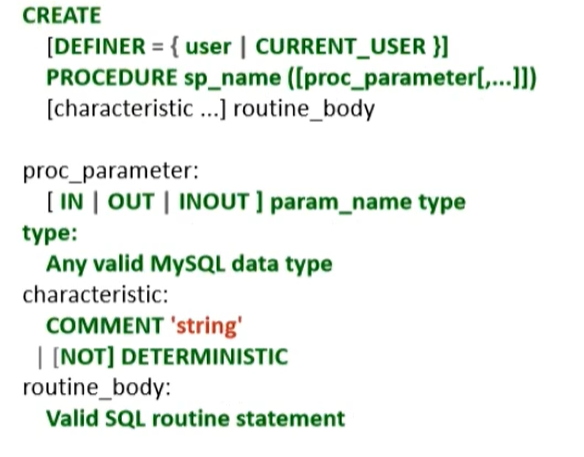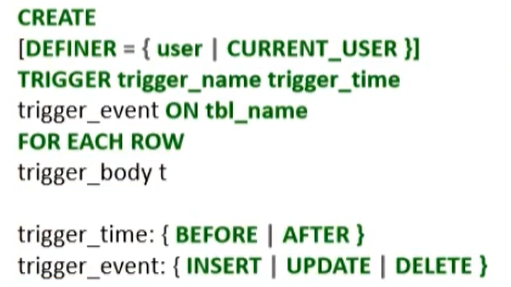存储过程和函数
相比Oracle, MySQL中很少使用存储过程。
1. 概述
- 存储在数据库端的一组SQL语句集
- 用户可以通过存储过程名和传参多次调用的程序模块
- 存储过程的特点:
- 使用灵活,可以使用流控制语句、自定义变量等完成复杂的业务逻辑
- 提高数据安全性,屏蔽应用程序直接对表的操作,易于进行审计
- 减少网络传输
- 但是提高代码维护的复杂度,实际使用中要评估场景是否适合
1. 存储过程之流控制
| 流程控制 | 语法 |
|---|---|
| if | IF search _condition THEN statement list [ELSElF search condition THEN statement list] [ELSE statement list] END IF |
| case | CASE case__value WHEN when_value THEN statement list [ELSE statement_list] END CASE |
| while | WHILE search_condition DO statement list END WHILE |
| repeat | REPEAT statement listUNTlL search condition END REPEAT |
2. 存储过程之基本语法

3. 存储过程之实操
3.1 创建存储过程
sql
DELIMITER //
create procedure sql_trains.proc_test1(in total int, out res int)
begin
declare i int;
set i=1;
set res = 1;
if total <= 0 then
set total = 1;
end if;
while i <= total do
set res = res * i;
insert into sql_trains.tbl_proc_test values (res);
set i=i+1;
end while;
select max(num) from sql_trains.tbl_proc_test;
end; //
delimiter ;其中使用delimiter定义语句结束符不再是;结尾,避免语句块录入时被误认为是单个sql。
sql
call sql_trains.proc_test1(10, @a);
-- 获取结果
select @a;3.2 查询存储过程
sql
-- 查询具体存储过程状态
show procedure status like '%proc%';
-- 查询具体存储过程信息
select * from information_schema.routines where routine_schema='sql_trains';
-- 在mysql5.7之前,存储过程信息存放在 mysql.proc 表中
SELECT * FROM mysql.proc WHERE db = 'sql_trains;4. 自定义函数
必须指明返回值。
sql
DELIMITER //
create function sql_trains.func_test1 (total int)
returns bigint
-- 开启二进制日志需要加上这一行
DETERMINISTIC
begin
declare i int;
declare res bigint;
set i = 1;
set res = 1;
if total <= 0 then
set total = 1;
end if;
while i <= total do
set res = res * i;
set i = i + 1;
end while;
return res;
end; //
delimiter ;调用函数:
sql
select sql_trains.func_test1(3);4. 触发器
特点是一触即发,当表上出现特定的事件时触发该程序执行,触发器类型有UPDATE/DELETE/INSERT。
4.1 语法

4.2 触发的操作
 需要注意的是:
需要注意的是:
- replace操作如果是数据已存在还会触发删除触发器
- drop和truncate操作不会触发删除触发器
sql
create table sql_trains.stu(
name varchar(50),
course varchar(50),
score int,
primary key (name)
);
DELIMITER //
create trigger sql_trains.trg_upd_score
before update on stu
for each row
begin
if NEW.score<0 then
set NEW.score=0;
elseif NEW.score>100 then
set NEW.score=100;
end if;
end; //4.3 触发器总结
- 触发器对性能有损耗,应当非常慎重使用
- 对于事务表,触发器执行失败则整个语句回滚
- Row格式主从复制,触发器不会在从库上执行
- 使用触发器时应防止递归执行
4.4 触发器高级使用
所谓物化视图:
- 不是基于基表的虚表
- 根据基表实际存在的实表
- 预先计算并保存多表的链接(JOIN)或聚集(GROUPBY)等耗时较多的SQL操作结果
sql
-- 创建物化视图
CREATE TABLE sql_trains.Orders_MV(
product name VARCHAR(30) NOT NULL,
price_sum DECIMAL(8,2) NOT NULL,
amount_sum INT NOT NULL,
price_aVg FLOAT NOT NULL,
orders_cnt INT NOT NULL,
UNIQUE INDEX (product_name)
);
-- 创建普通视图
CREATE VIEW sql_trains.v_orders AS SELECT
product_name, sum(price), sum(amount), avg(price), coynt(1)
FROM Orders
GROUP BY product_name;
CREATE TRIGGER tgr_Orders_insert
AFTER INSERT ON Orders
FOR EACH ROW
BEGIN
SET @old_price_sum = 0;
SET @old_amount_sum = 0;
SET @old_price_avg = 0;
SET @old_orders_cnt = 0;
SELECT
IFNULL(price_sum, 0),IFNULL(amount_sum, 0), IFNULL(price_avg, 0), IFNULL(orders_cnt, 0)
FROM Orders_MV
WHERE product_name = NEW.product_name
INTO @old_price_sum, @old_amount_sum,@old_price_avg, @old_orders_cnt;
SET @new_price_sum=@old_price_sum + NEW.price;
SET @new_amount_sum= @old_amount_sum + NEW.amount;
SET @new_orders_cnt = @old_orders_cnt + 1;
SET @new_price_avg = @new_price_sum/@new_orders_cnt ;
REPLACE INTO Orders_Mv
VALUES(NEW.product_name, @new_price_sum, @new_amount_sum, @new_price_avg, @new_orders_cnt );
end;